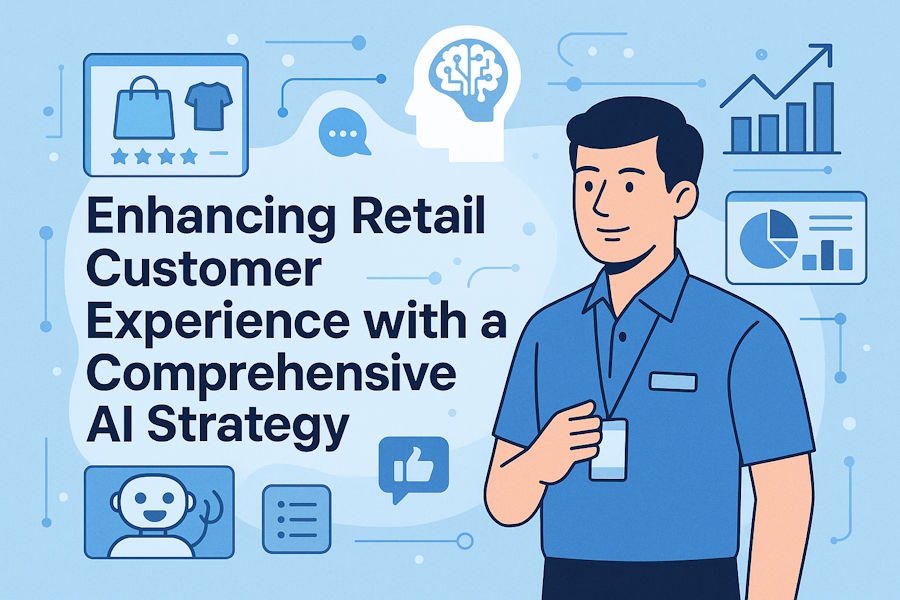In today's retail landscape, businesses face mounting pressure to meet ever-rising customer expectations. Modern shoppers demand convenience, personalization, and seamless experiences across all touchpoints, pushing retailers to find innovative solutions to stay competitive. Artificial intelligence has emerged as a transformative tool in this quest.
AI for customer experience is revolutionizing retail by enabling more meaningful, personalized interactions throughout the customer journey. By analyzing vast amounts of data in real-time, AI uncovers patterns and insights that humans simply couldn't identify manually, leading to smarter decisions and improved experiences.
Adopting a comprehensive AI strategy has become essential in our digital marketplace. Today's customers expect retailers to understand their preferences, anticipate their needs, and provide relevant recommendations while creating frictionless shopping experiences.
When implemented effectively, AI drives tangible business outcomes beyond just improving satisfaction metrics - from increased loyalty and conversion rates to operational efficiencies and better resource allocation. However, success requires a strategic approach that aligns with business objectives, addresses specific pain points, and considers ethical implications. Retailers need a clear vision and implementation roadmap that balances short-term wins with long-term transformation.
Key Elements of a Comprehensive AI Strategy for Retail
AI strategy consulting helps enhance retail customer experience by encompassing multiple technologies and approaches, each addressing different aspects of the customer journey. Let's explore the five key elements that retailers should consider when developing their AI strategy:
Personalization at Scale
Personalization has become a cornerstone of exceptional customer experiences in retail. Customers expect retailers to understand their preferences and provide relevant recommendations, offers, and content. However, delivering truly personalized experiences to thousands or millions of customers presents significant challenges.
AI makes personalization at scale possible by analyzing customer data from multiple sources, including purchase history, browsing behavior, social media interactions, and demographic information. Using this data, AI algorithms can segment customers into meaningful groups and even treat each customer as a segment of one, tailoring experiences to individual preferences and behaviors.
The applications of AI-driven personalization in retail are diverse and powerful:
- Product recommendations that evolve based on changing customer preferences
- Dynamic pricing strategies that balance customer value perception with profit margins
- Personalized marketing messages that resonate with specific customer segments
- Customized website layouts that highlight products most relevant to each visitor
- Tailored loyalty programs that reward customers based on their unique behaviors
The key to successful personalization lies in balancing relevance with privacy concerns. Retailers must be transparent about how they collect and use customer data, providing clear value in exchange for the information customers share. When done right, personalization creates a virtuous cycle where customers willingly provide more data because they receive better experiences in return.
Intelligent Chatbots and Virtual Assistants
Customer service is a critical touchpoint in the retail experience, but providing consistent, high-quality support across all channels can be challenging. Intelligent chatbots and virtual assistants powered by AI are transforming customer service by offering immediate, accurate responses to common queries while freeing human agents to handle more complex issues.
Modern AI-powered conversational systems have evolved far beyond simple rule-based chatbots. Today's solutions use natural language processing (NLP) and machine learning to understand customer intent, maintain context throughout conversations, and continuously improve their responses based on feedback and interactions.
These intelligent assistants can support customers in numerous ways:
- Answering product questions and providing detailed specifications
- Tracking order status and handling return requests
- Offering personalized product recommendations based on customer preferences
- Guiding customers through complex processes like financing applications
- Collecting feedback and resolving simple complaints
The most effective implementations combine AI assistants with human agents in a seamless handoff system. AI handles routine inquiries efficiently while identifying when human intervention is needed and transferring the conversation along with relevant context. This hybrid approach ensures that customers receive the right level of support for their specific needs, improving satisfaction while optimizing operational efficiency.
As these systems continue to evolve, they're becoming increasingly sophisticated in understanding customer emotions and adapting their communication style accordingly. The future of retail customer service will likely see even more natural, empathetic AI assistants that can build genuine rapport with customers while still delivering efficient service.
Predictive Analytics for Enhanced Customer Insights
Understanding customer behavior has always been crucial in retail, but traditional methods often rely on historical data that may not accurately predict future actions. Using AI to improve customer experience involves leveraging predictive analytics to anticipate customer needs and behaviors before they occur, enabling retailers to be proactive rather than reactive.
Predictive analytics uses machine learning algorithms to analyze patterns in customer data and forecast future behaviors with remarkable accuracy. These insights allow retailers to optimize their operations, inventory, marketing, and customer service strategies based on what customers are likely to do next.
The applications of predictive analytics in retail include:
- Forecasting demand for specific products to optimize inventory levels
- Predicting customer churn and implementing targeted retention strategies
- Identifying customers who are ready to make a purchase and delivering timely offers
- Anticipating seasonal trends and adjusting marketing strategies accordingly
- Predicting lifetime customer value to inform acquisition and retention investments
What makes predictive analytics particularly powerful is its ability to uncover non-obvious relationships in data. For example, an algorithm might discover that customers who purchase certain combinations of products are likely to be interested in a seemingly unrelated item. These insights can lead to unexpected opportunities for cross-selling and upselling that human analysts might never identify.
To maximize the value of predictive analytics, retailers should focus on collecting high-quality data from multiple sources and ensuring that insights are actionable. The most successful implementations integrate predictive insights directly into operational systems, enabling automatic adjustments to marketing campaigns, inventory levels, pricing strategies, and customer communications.
AI-Driven Customer Feedback Analysis
Understanding customer sentiment is essential for improving retail experiences, but traditional feedback collection and analysis methods often provide limited insights. Manual analysis of surveys, reviews, and social media mentions is time-consuming and subjective, making it difficult to identify meaningful patterns across thousands of customer interactions.
AI technologies, particularly natural language processing and sentiment analysis, transform how retailers collect, analyze, and act on customer feedback. These systems can automatically process vast amounts of unstructured text data from multiple sources, extracting key themes, sentiment, and actionable insights in real-time.
The benefits of AI-driven feedback analysis include:
- Identifying emerging issues before they become widespread problems
- Understanding the emotional impact of different aspects of the customer experience
- Tracking sentiment trends over time to measure the effectiveness of improvements
- Detecting subtle differences in preferences across customer segments
- Uncovering specific product features or service elements that drive satisfaction or dissatisfaction
Advanced AI feedback systems don't just analyze text—they can also process images, video, and audio to provide a more comprehensive understanding of customer sentiment. For example, computer vision algorithms can analyze customer facial expressions in store videos, while speech analysis can detect emotional cues in customer service calls.
The most valuable aspect of AI-driven feedback analysis is its ability to close the loop between customer insights and action. By integrating feedback systems with operational platforms, retailers can ensure that insights trigger appropriate responses, whether that's addressing an individual customer's concern or implementing a systematic improvement to prevent similar issues in the future.
Optimizing In-Store Experience with AI
Despite the growth of e-commerce, physical stores remain a crucial part of the retail ecosystem. AI technologies are now bridging the gap between digital and physical retail, creating smart stores that combine the convenience and personalization of online shopping with the immediacy and sensory experience of brick-and-mortar retail.
Computer vision, IoT sensors, and mobile technologies enable retailers to gather and analyze data about customer behavior in physical stores similarly to how they track online behavior. This data powers AI systems that can optimize store layouts, staffing, inventory placement, and customer interactions.
Key applications of AI in physical retail environments include:
- Smart fitting rooms with interactive mirrors that recommend complementary items
- Computer vision systems that analyze foot traffic patterns and dwell times
- Automated checkout solutions that eliminate waiting lines
- Location-based mobile notifications with personalized offers
- Dynamic digital signage that adapts content based on nearby customers
The most innovative retailers are creating unified customer profiles that combine online and offline data, enabling truly omnichannel experiences. For example, a customer who has been browsing certain products online might receive a mobile notification about those items when they enter a physical store, along with directions to their location and any relevant promotions.
AI technologies also help retailers optimize operational aspects of physical stores, such as staff scheduling based on predicted foot traffic, inventory positioning based on anticipated demand, and even temperature and lighting adjustments based on customer preferences and energy efficiency goals.
The Future of AI in Retail Customer Experience
As we look toward the future, it's clear that AI will play an increasingly central role in shaping retail customer experiences. The retailers who thrive will be those who view AI not just as a technological tool but as a strategic asset that can differentiate their brand and build stronger customer relationships.
The next generation of retail AI solutions will likely feature even more seamless integration across channels, greater emotional intelligence in customer interactions, and more autonomous decision-making capabilities. We may see AI systems that can not only respond to customer needs but anticipate them before customers themselves are aware of them, creating truly frictionless experiences that feel magical rather than mechanical.
However, as AI becomes more pervasive in retail, businesses must remain focused on the human element of customer experience. The goal should not be to replace human connections with AI but to use AI to enhance these connections—freeing employees from routine tasks so they can focus on creating meaningful moments that build emotional bonds with customers.
Retailers that invest in developing a comprehensive AI strategy today will be well-positioned to meet evolving customer expectations and lead the way in customer service innovation. By thoughtfully integrating AI technologies into their operations and customer touchpoints, these forward-thinking businesses will create experiences that are not just satisfying but truly delightful—turning customers into loyal advocates who return again and again.








